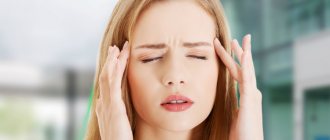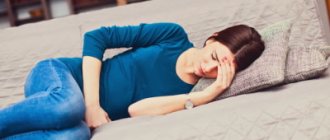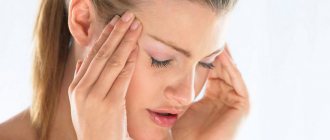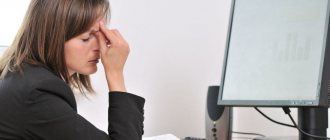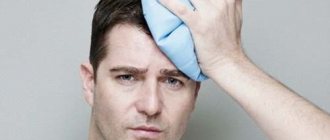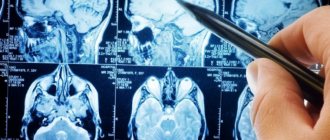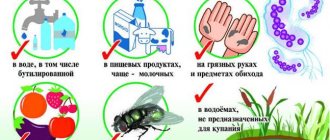Head neurosis is a mental disorder that occurs against the background of psychological overload, manifested by headaches and dizziness, which can be combined with other psycho-emotional and somatic symptoms: anxiety, restlessness, decreased performance, emotional lability, palpitations, disorders of the gastrointestinal tract and genitourinary organs.
Reasons for development
The cause of any neurosis is the impact of psychotraumatic factors: prolonged, mildly expressed stressful situations or one-time severe stress, lack of security, the inability to openly express feelings or implement plans, etc. If the listed circumstances exceed the mental capacity for self-healing, a breakdown in adaptation occurs, the person ceases to cope even with everyday life. loads. Predisposing circumstances are considered:
- Serious changes in life . Both negative and positive events matter. The development of a neurotic disorder can be caused by dismissal from work, the death of a loved one or family troubles, as well as a wedding, the birth of a child, or a large win in the lottery.
- Temperament type . Choleric and melancholic people are more prone to developing the disease. Stable types of temperament - phlegmatic and sanguine people - can also suffer from neuroses, but in them, due to the innate characteristics of the psyche, the disease develops with longer and more intense exposure.
- Constant overload . Large volumes of work, lack of sufficient rest, and inability to relax even on weekends gradually exhaust the nervous system and increase its susceptibility to traumatic influences.
- Other factors . Chronic intoxication and long-term somatic diseases create an increased burden on the body and predispose to the development of mental disorders.
Head symptoms
Headache with neurosis is in most cases observed in patients with hysteria and neurasthenia, and is rarely found in obsessive-compulsive disorder. When you refuse to acknowledge your feelings, the tendency to hide your experiences can come to the fore and occupy a leading place in the picture of the disease. Often combined with insomnia and decreased appetite. The cause is overstrain of the head and neck muscles, deterioration of blood supply to the brain due to changes in vascular tone. The most common options are the following:
- compressive diffuse pain covering the head in the form of a helmet;
- constant tension, a feeling of “cotton head”, which prevents memorization, analysis, planning, and solving intellectual problems;
- throbbing pain;
- migraine-like pain.
The predominant localization is the forehead, back of the head, temples. At the same time, it is often difficult to clearly indicate the epicenter or determine the nature of the sensations. Possible combination with weakness and nausea. Typically occurs or worsens after intense experiences.
Dizziness is observed in patients with panic attacks, phobias, anxiety disorders, depression, and vegetative-vascular dystonia. Non-systemic, combined with tinnitus, sometimes accompanied by pre-syncope. The psychogenic origin of the symptom is supported by the absence of hearing impairment and gait disorders. However, to exclude the organic origin of the pathology, a detailed examination is necessary.
How to get rid of neurogenic headaches
The effectiveness of treatment for neurological headaches largely depends on the correct determination of the cause and nature of the pain. Cerebral circulation disorders require the use of blood pressure normalizing agents, diuretics, sedatives, and antioxidants. Complexes selected by doctors quickly eliminate both pain and its cause. Pain caused by muscle strain is relieved by massage, physical therapy, and physiotherapy. Treatment of headaches from compression of nerves and blood vessels is carried out using painkillers. Acupuncture and manual techniques are very effective in this case. Problems caused by brain hypoxia can be eliminated by access to fresh air, room ventilation, and breathing exercises. Migraine requires treatment with a specific selection of medications and the use of laser therapy.
Other signs
Along with the listed manifestations, the following may be observed:
- decreased sensitivity and paresthesia in the extremities;
- sleep disorders: difficulty falling asleep, frequent awakenings, disturbing dreams and nightmares, early awakenings or, on the contrary, too much sleep in the morning with problems at night, daytime sleepiness;
- inability to fully relax even when very tired;
- mood swings, anxiety, restlessness, irritability, depression, inability to experience positive emotions;
- cognitive impairment, decreased intellectual abilities;
- weakness, fatigue, apathy, touchiness, tearfulness;
- tendency to get “stuck” in experiencing a stressful situation;
- causeless pain in the body;
- increased sensitivity to external stimuli: loud sounds, bright light, temperature changes;
- autonomic disorders: dyspepsia, blood pressure instability, palpitations, increased sweating;
- decreased sexual desire, sexual dysfunction;
- loss of appetite, difficulty eating due to insufficient saliva production;
- attacks of anxiety and fear not related to external circumstances.
The severity and number of symptoms vary significantly - some patients exhibit 1 or 2 symptoms from the list above, others exhibit all or almost all manifestations.
A characteristic feature is the presence of muscle tension that occurs due to constant overexertion. Their localization is determined by prevailing experiences. Hostility towards others provokes an increase in the tone of the shoulder girdles and upper limbs. Sexual problems cause tension in the muscles of the pelvis and hips. The feeling of constant tension in the head is associated with decreased self-esteem and unresolved external and internal conflicts.
Features of the course in men
Neurosis occurs differently in all people. In women, the hysterical variety is more often found. Characterized by unstable behavior, dramatization of situations, tears and screams. Symptoms when treating neurosis in men who require treatment are somewhat different. They are less likely to encounter a diagnosis, but more often progress the condition to its extreme stages. In representatives of the stronger sex, the diagnosis is often associated with overexertion and workaholism. Common features include:
- Aggression. Reactions to familiar things become acute. A man responds to everyday events with anger.
- Low self-esteem. A person does not believe in himself and is afraid to start a new business.
- Strong self-criticism. They place high and sometimes unattainable demands on themselves.
- Inability to adapt to the situation. Even a small failure unsettles a man with neurosis.
Of particular importance for representatives of the stronger sex is such a manifestation as decreased libido. Sexual life is becoming less and less attractive. In addition, there is a complete or partial absence of erection. This leads to the progression of a nervous disorder and forces one to completely withdraw into oneself. It is important that the male half of society has always been distinguished by hushing up its own problems. Hiding the facts and the lack of measures taken also provokes the development of HP in a man.
Cost of services
| CONSULTATIONS OF SPECIALISTS | |
| Initial consultation with a psychiatrist (60 min.) | 6,000 rub. |
| Repeated consultation | 5,000 rub. |
| Consultation with a psychiatrist-narcologist (60 min.) | 5,000 rub. |
| Consultation with a psychologist | 3,500 rub. |
| Consultation with Gromova E.V. (50 minutes) | 12,000 rub. |
| PSYCHOTHERAPY | |
| Psychotherapy (session) | 7,000 rub. |
| Psychotherapy (5 sessions) | 30,000 rub. |
| Psychotherapy (10 sessions) | 60,000 rub. |
| Group psychotherapy (3-7 people) | 3,500 rub. |
| Psychotherapy session with E.V. Gromova (50 minutes) | 12,000 rub. |
This list does not contain all prices for services provided by our clinic. The full price list can be found on the “Prices” , or by calling: 8(969)060-93-93. Initial consultation is FREE!
Treatment
Comprehensive therapeutic measures are recommended, including drug support, psychotherapy and lifestyle changes. You should review your daily routine and the amount of exercise, rest regularly, move enough, and eat well. As part of drug treatment, the following is prescribed:
- herbal remedies with a sedative effect: motherwort, valerian, peony tincture, etc.;
- painkillers, preferably those that simultaneously eliminate muscle and vascular spasms;
- anti-anxiety medications, nootropics, sleeping pills;
- vitamin and mineral complexes.
In severe cases, antidepressants are indicated. The use of these medications in various combinations helps eliminate pain, normalize muscle tone, restore sleep and appetite, and reduce the severity of emotional experiences.
The type of psychotherapeutic correction is determined by the type and severity of the cerebral neurosis and the patient’s personal characteristics. Cognitive-behavioral and psychodynamic techniques, art therapy and other areas are used. In some cases, hypnosis is effective. The following physical methods are used to reduce muscle tension:
- water procedures;
- relaxation massage;
- aromatherapy;
- reflexology;
- special manual techniques.
After eliminating the symptoms, it is necessary to follow certain rules to avoid relapse of the disease. When planning your schedule, you should leave enough time for rest, maintain moderate physical activity, regularly spend time in the fresh air, do not refuse vacations, avoid overtime, and avoid stress if possible.
Prevention
Primary and secondary prevention of HP plays an important role. Even after complete recovery, it is important to follow recommendations to prevent relapse. The prevention program involves actions such as:
- Maintaining a healthy lifestyle. A balanced diet, adherence to sleep and rest, and exercise are the main pillars of a healthy nervous system. Narcotic substances are strictly prohibited. You should not drink alcohol regularly or in large quantities. It is advisable to completely give up tobacco products.
- Prevention of traumatic effects. One of the main goals is to minimize stress, avoid conflicts, and maintain a favorable emotional atmosphere.
- Following the principles of proper education. You should not instill in children the idea of their exclusivity and superiority or, conversely, artificially diminish their successes and merits.
- Maintaining adequate lighting. A banal lack of light often leads to the appearance of the first signs of neurosis and depression. It is worth giving up thick curtains and using bright lighting in the evening. Light helps produce serotonin, a neurotransmitter that has a positive effect on mood.
- Timely detection and treatment of pathologies. It is important to be regularly examined and urgently stop disorders of the endocrine, nervous, cardiovascular and other systems. Advanced pathologies significantly increase the risk of nervous disorder.

